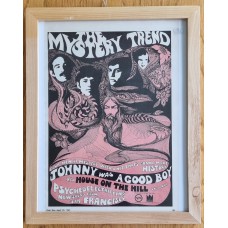MYSTERY TREND - original "Cash Box Magazine" Advertisement Poster 39x31cm framed for "Johnny Was A Good Boy" 45 | condition: NM (mint-) all the way.
Cashbox, also known as Cash Box, is an American music industry trade magazine, originally published weekly from July 1942 to November 1996. Ten years after its dissolution, it was revived and continues as Cashbox Magazine, an online magazine with weekly charts and occasional special print issues.[1] In addition to the music industry, the magazine covered the amusement arcade industry, including jukebox machines and arcade games.
History
Print edition charts (1952–1996)
Cashbox was one of several magazines that published record charts in the United States. Its most prominent competitors were Billboard and Record World (known as Music Vendor prior to April 1964). Unlike Billboard, Cashbox combined all currently available recordings of a song into one chart position with artist and label information shown for each version, alphabetized by label. Originally, no indication of which version was the biggest seller was given, but from October 25, 1952, a star was placed next to the names of the most important artists. Cashbox also printed shorter jukebox charts that included specific artist data beginning in spring 1950. Separate charts were presented for jukebox popularity, record sales and radio airplay. This was similar to Billboard's methodology prior to August 1958, when Billboard debuted its "Hot 100", which attempted to combine all measures of popularity into one all-encompassing chart. In addition, Cashbox published chart data for specific genres, such as country music and R&B music. In 1960, Cashbox discontinued its R&B chart after the March 5 issue; it was reinstated in the December 17 issue due to popular demand. The chart was originally dropped because it became dominated by pop records.[2]
Cashbox was a competitor to Billboard through the 1950s and 1960s, but two factors spelled its decline in 1970. Archivist and record historian Joel Whitburn published his first research book based on the Billboard Hot 100, which made that data the "Bible" for official historic chart positions. In addition, the syndicated radio series American Top 40 with Casey Kasem used Billboard chart statistics, cementing Billboard as the dominant chart data for current and historic reference. Magazine publisher George Albert compiled Cashbox chart data for a reference book more than a decade later, and Dick Clark used Cashbox information for a time on his National Music Survey, beginning in 1981. However, by that time, the trend was set.
MYSTERY TREND original April 22 1967 "Cash Box Magazine" Advertisement Poster 39x31cm framed
- Product Code: Poster
- Availability: 1
-
55.00€




